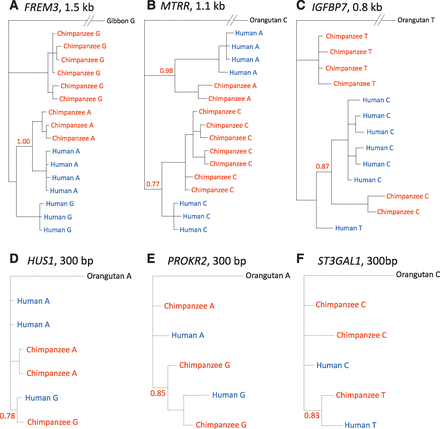Dennis,
Very interesting papers. I’ve read the first one already, but not the second. However, I am not sure how they help your case. As I understand it, you are trying to demonstrate…
- Homo sapiens specifically do not dip down to a single couple in 300 kya to the confidence we have in heliocentrism.
- Our ancestors as a whole do not dip down to a single couple between 300 kya and 3 mya with very high confidence, but maybe not as high.
As you put it…
As I understand it, the first claim appears to be novel, and I cannot find it in the literature anywhere. It would be help to see a paper that estimates population size of Homo sapiens specifically. I have not been able to find one. Have you?
The second one is only supported by the Ayala paper on MHCs, which is strong evidence in my view. The vast majority of studies are not even looking at population structure past 2 mya. So I am not sure how you get to high confidence at 2 mya to 3 mya.
As I read the papers you , the first paper…
This paper does not give a TMRCA > 4 mya for more than 4 alleles at any locus. They find 125 non MHC regions with ancestral variation, However, at none of these locations is there more than two or three haplotype clades shared by chimp and human. You can see some of them below; Figure 3…

The second paper is really an important paper, and I am glad you raised it. However, I am not sure how it helps your case. Table 2 and 3 give the TMRCAs the calculate in their method, which is notable for doing a much better job with recombination that most analysis:
This tables show the MAXIMUM estimates for TMRCA across the whole genome. Taking recombination into account, therefore, seems to REDUCED the estimates for TMRCA from 2 mya (as in your last study) to at most 600 kya. That measurement, however, appears to be an outlier. More consistently, we see TMRCA’s around 400 kya. [An error was made here. The TMRCA is by generation, not year. See my response below.]
Using our estimate that TMR4A approximately equals TMRCA / 4, that allows for a bottleneck after 100 kya (or 150 kya if want to use largest coalescence). This is consistent with TMRCAs from Y-chromosomes and mitochondria, and undermines your last paper too. I trust the TMRCAs here more than the 2 mya MRCA from the prior paper (which used a simplified analysis), because this is across the whole genome and uses a much more sophisticated method for detecting recombination. [An error was made here. The TMRCA is by generation, not year. See my response below.]
Now, it is possible when more data is used (rather than just the 69 genomes here) that a higher bound is placed. This is all strong evidence for common descent too. I am not sure, however, what this shows about your two claims. If anything, these two papers appear to undermine claim #1 and limit the amount of data we can expect to find for #2. [An error was made here. The TMRCA is by generation, not year. See my response below.]
Can you clarify how these papers help you?
Also, it seems odd to remind us all that absence of evidence is not evidence of absence.
[quote=“DennisVenema, post:308, topic:37039”]the literature to date that do not provide support for a bottleneck below ~10,000 at any time in the last 18MY (which remains the case).
[/quote]
This quote is helpful and accurate…
If someone were to assert that there is an elephant on the quad, then the failure to observe an elephant there would be good reason to think that there is no elephant there. But if someone were to assert that there is a flea on the quad, then one’s failure to observe it there would not constitute good evidence that there is no flea on the quad. The salient difference between these two cases is that in the one, but not the other, we should expect to see some evidence of the entity if in fact it existed.
— J.P. Moreland and W.L. Craig,
I’m not sure we expect to see any evidence against a brief bottleneck in the very distant past (before TMRCA4). We do find the strongest evidence in transpecies variation of MHC, but that is remarkable. As far as I know, that is the strongest evidence there is (and I have always pointed to it).
However, appealing to lack of evidence is only meaningful if we expect to see evidence. It certainly does not get us to “heliocentrism level certainty”.
